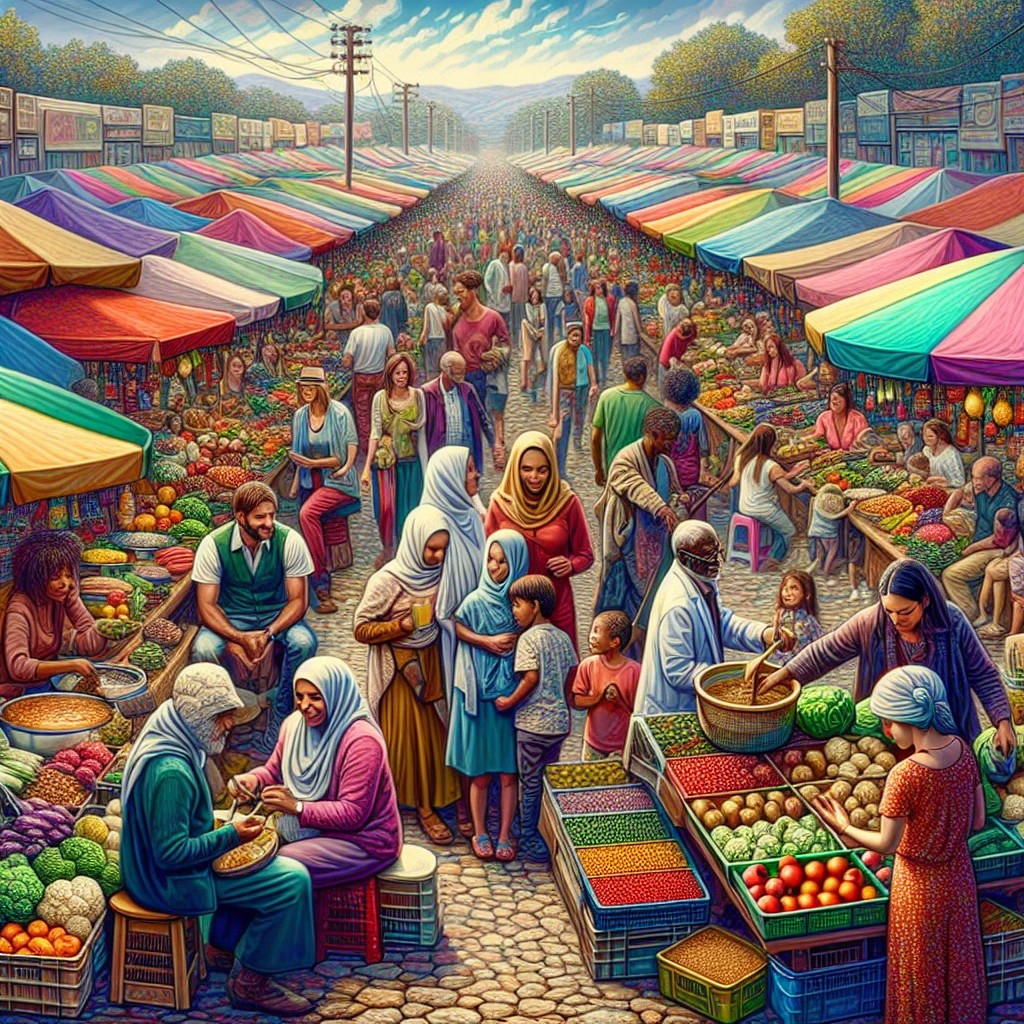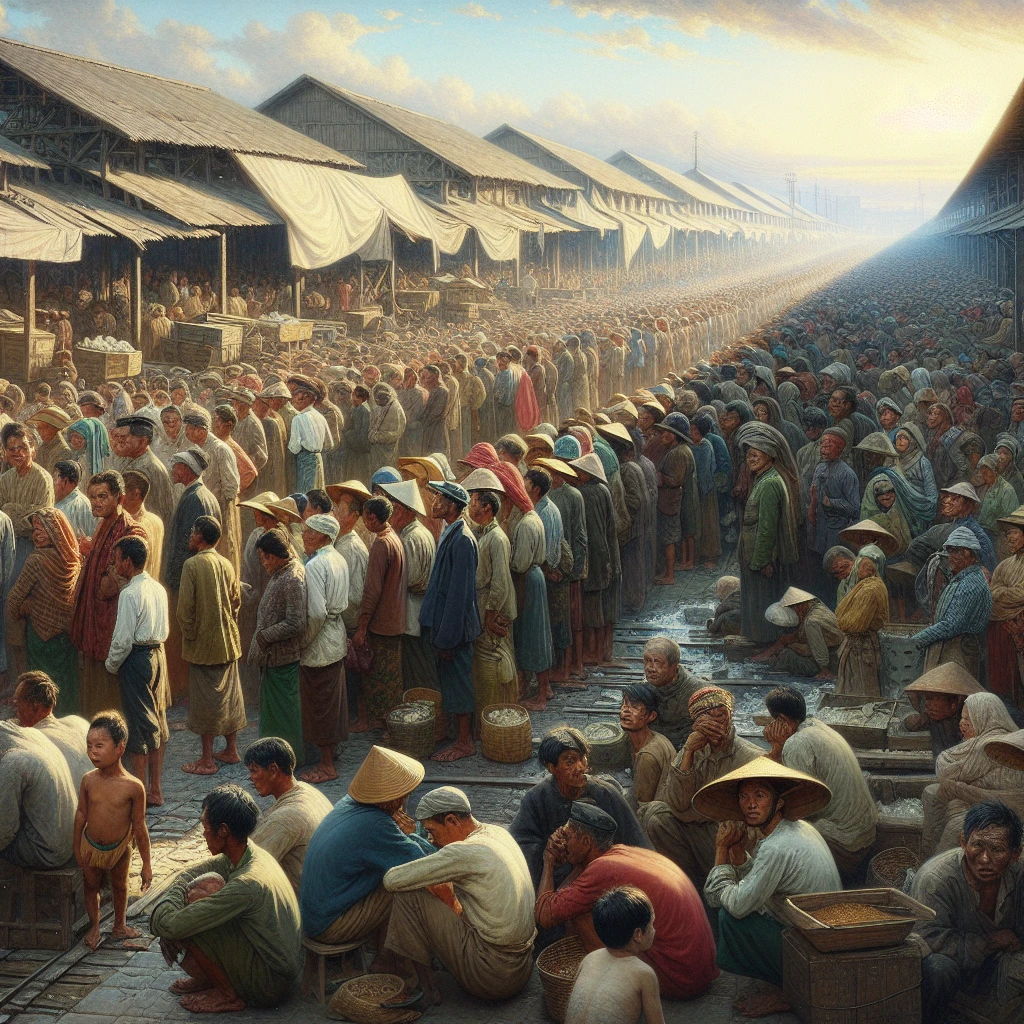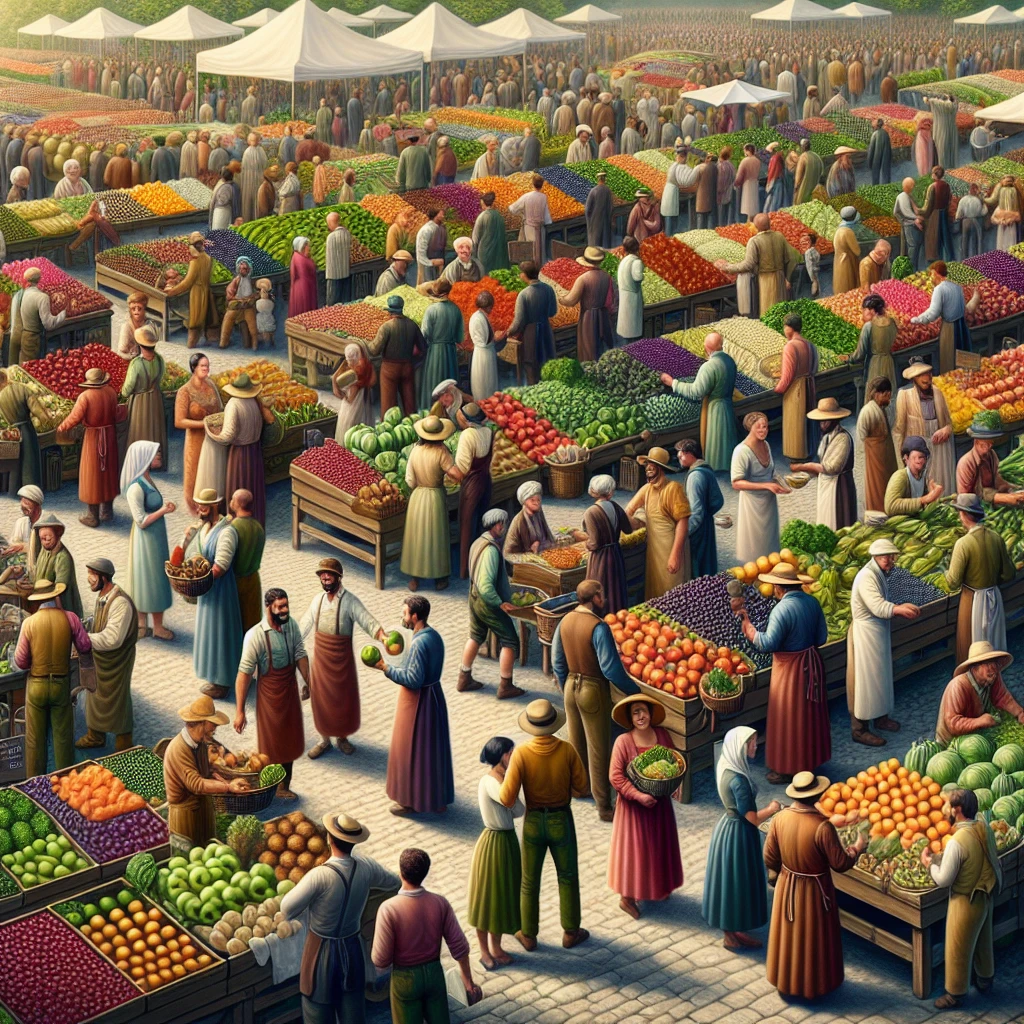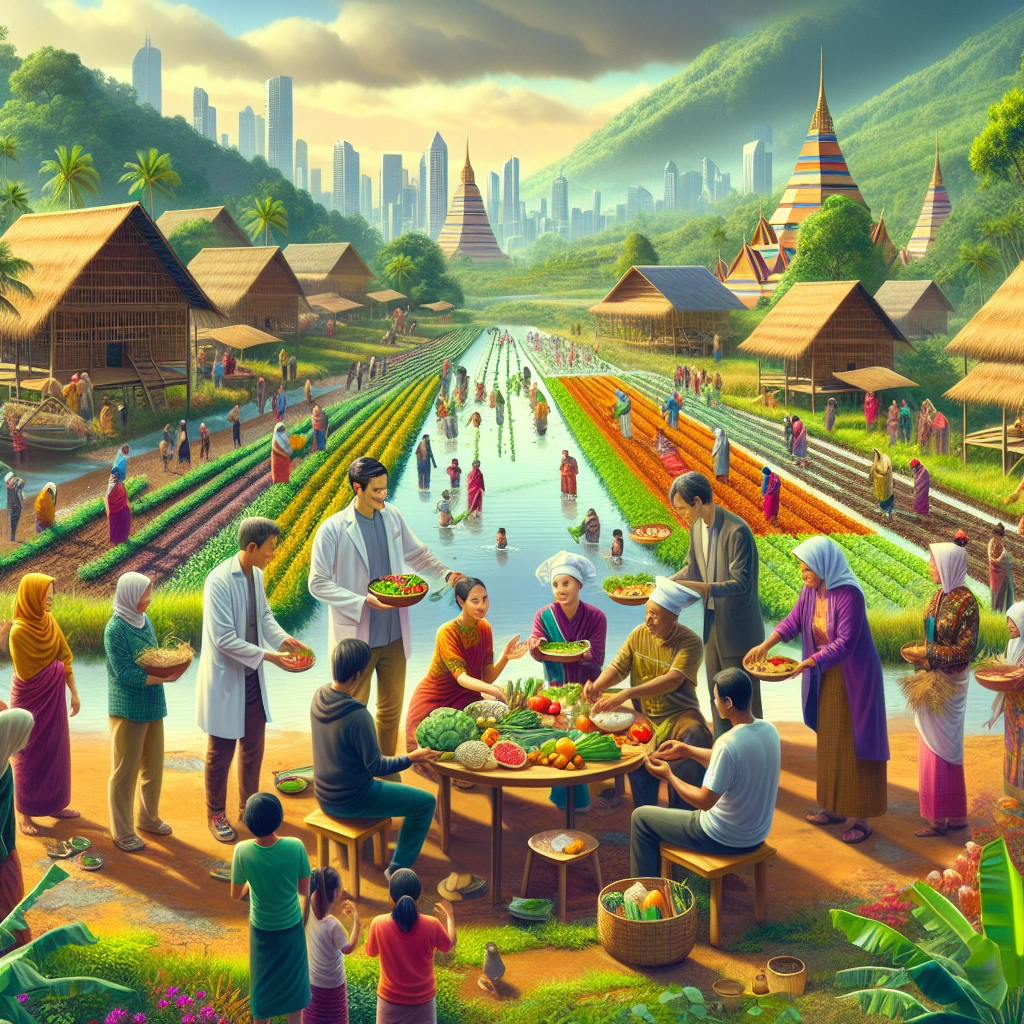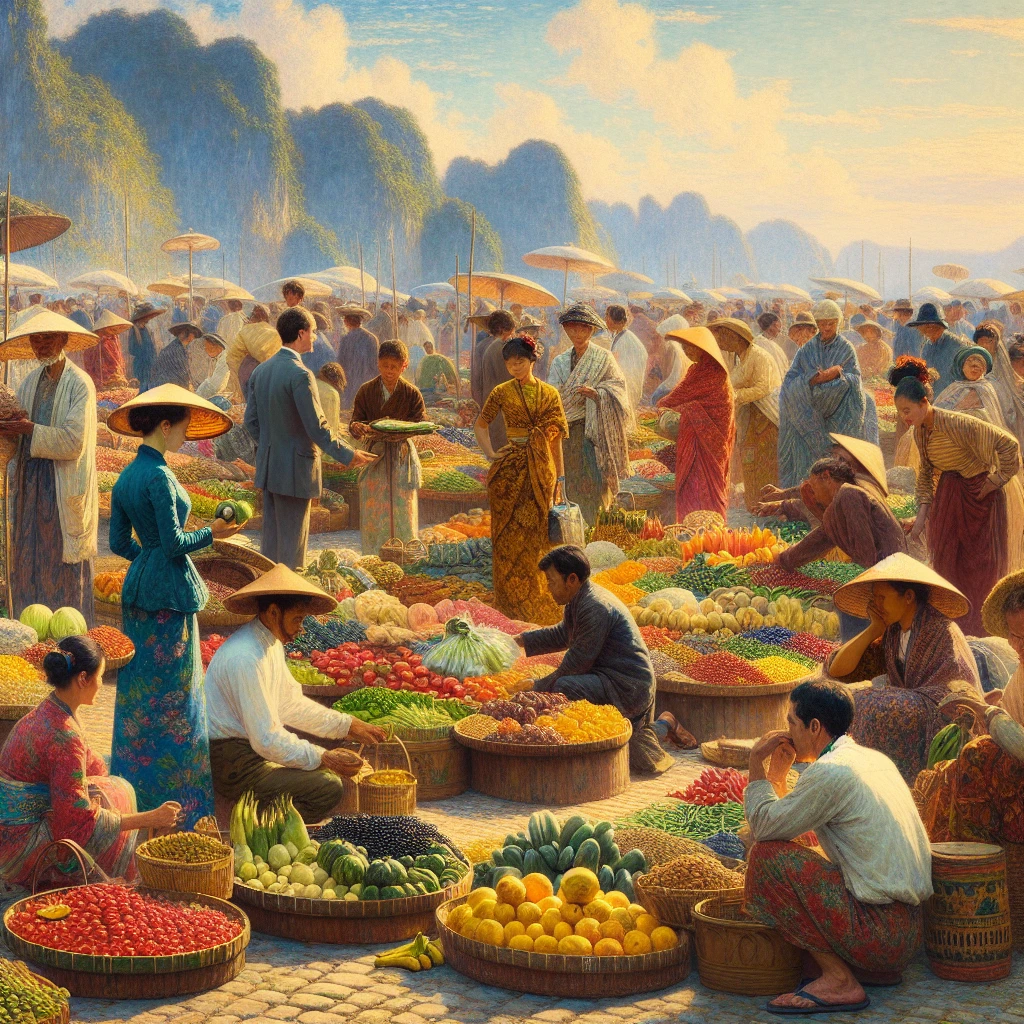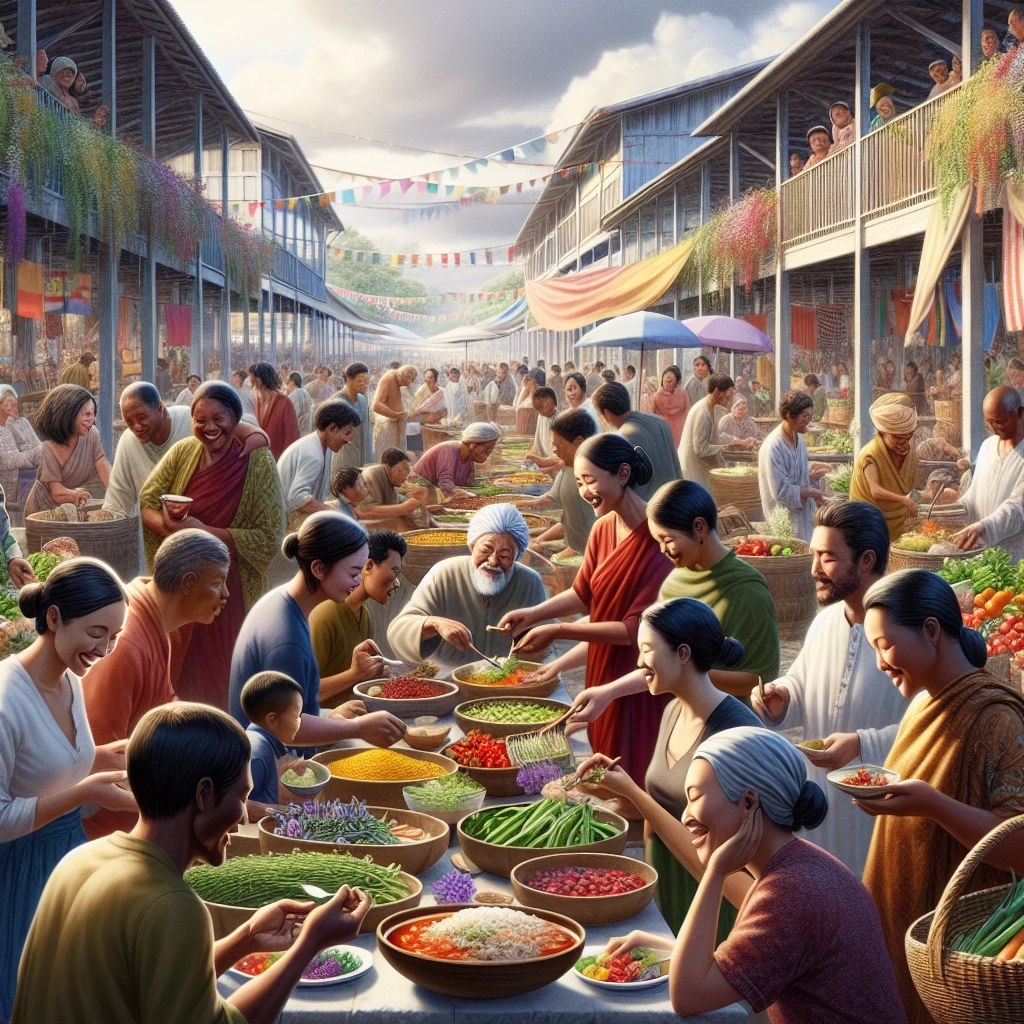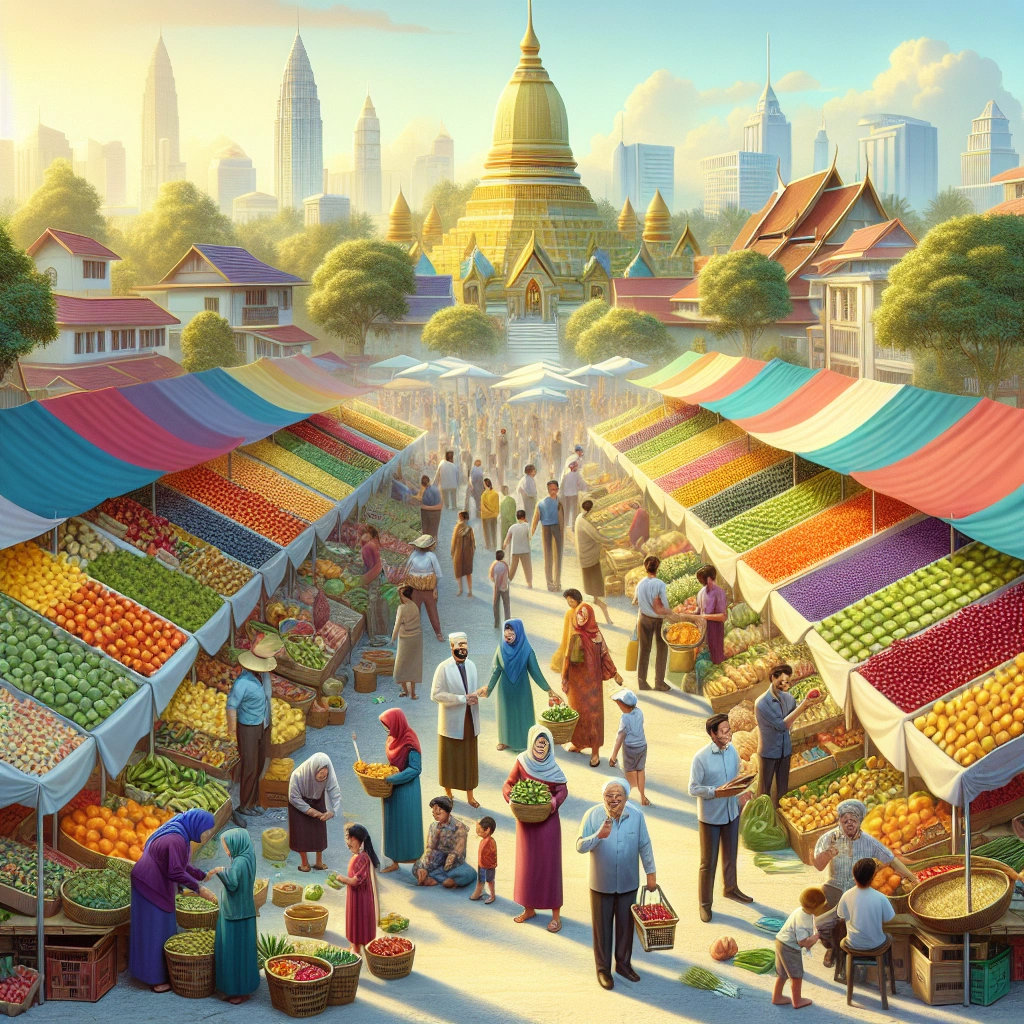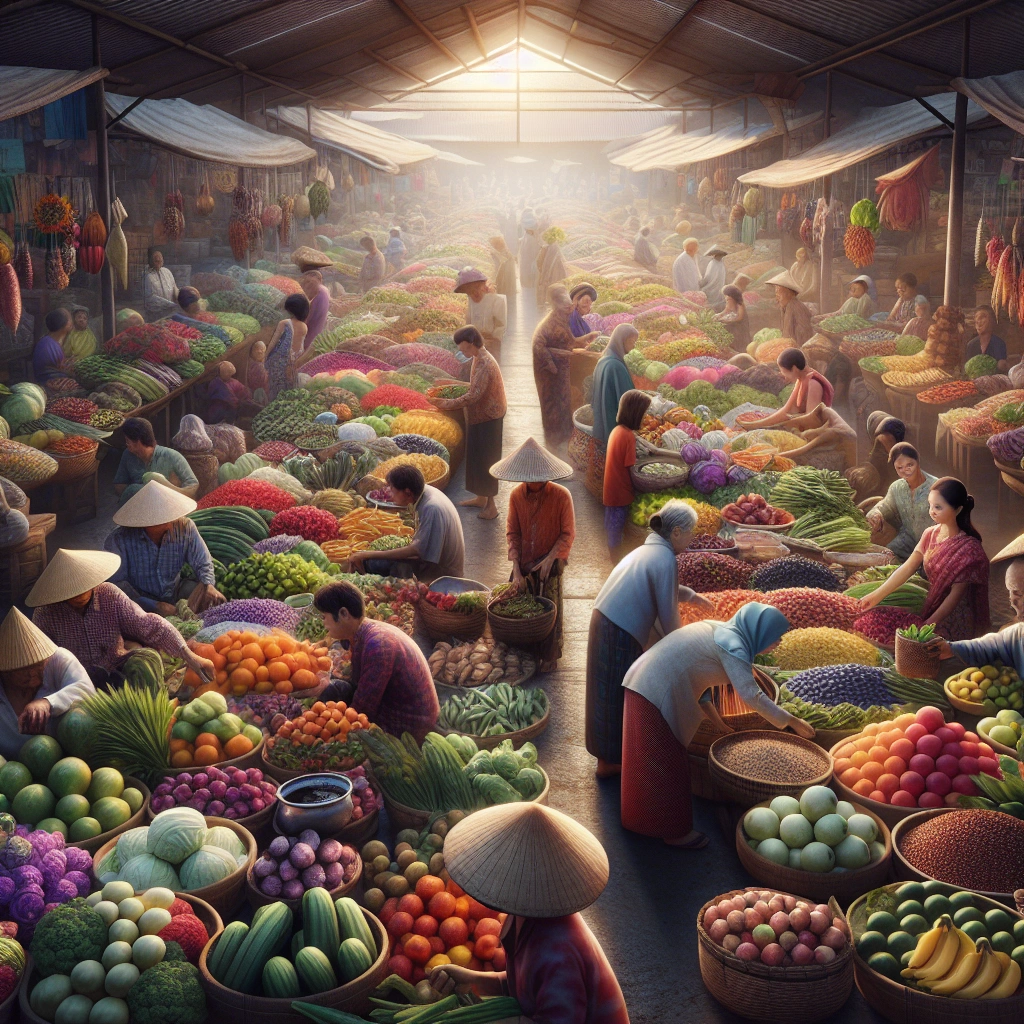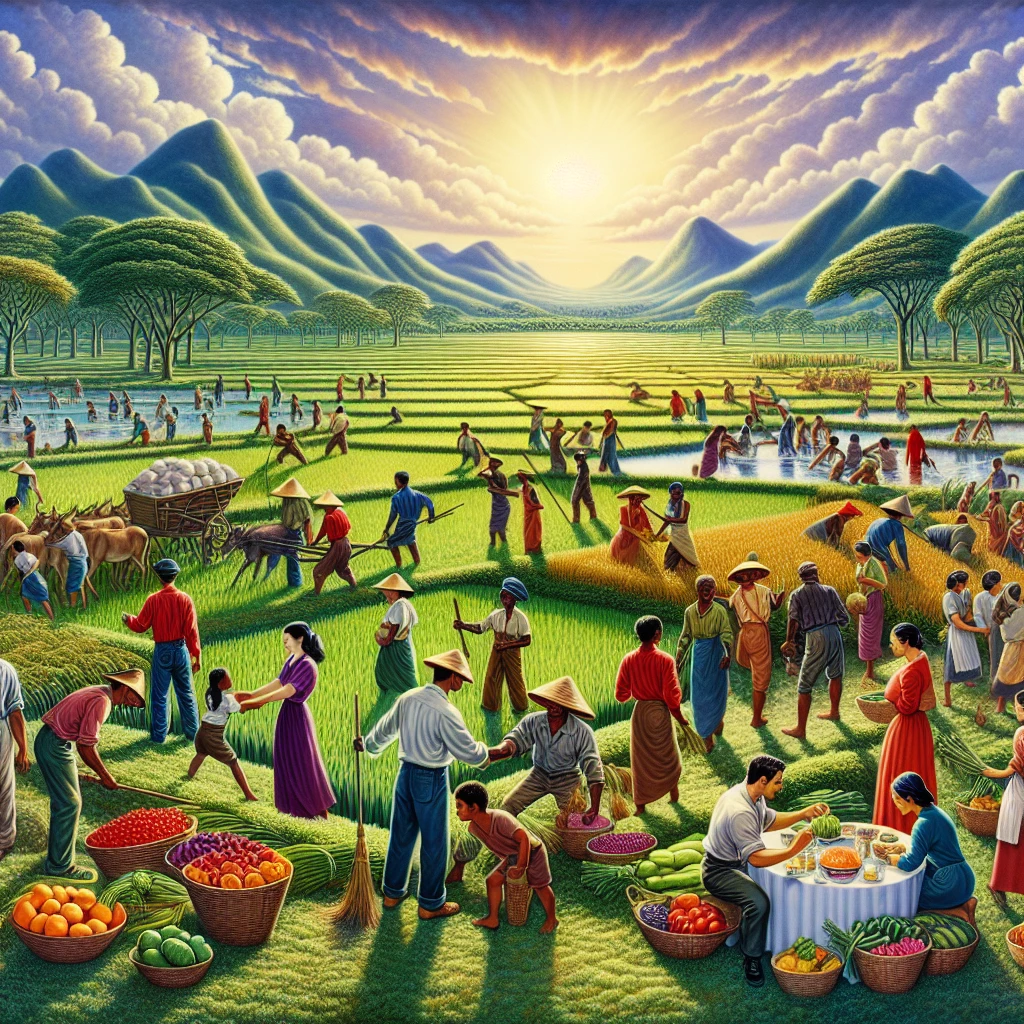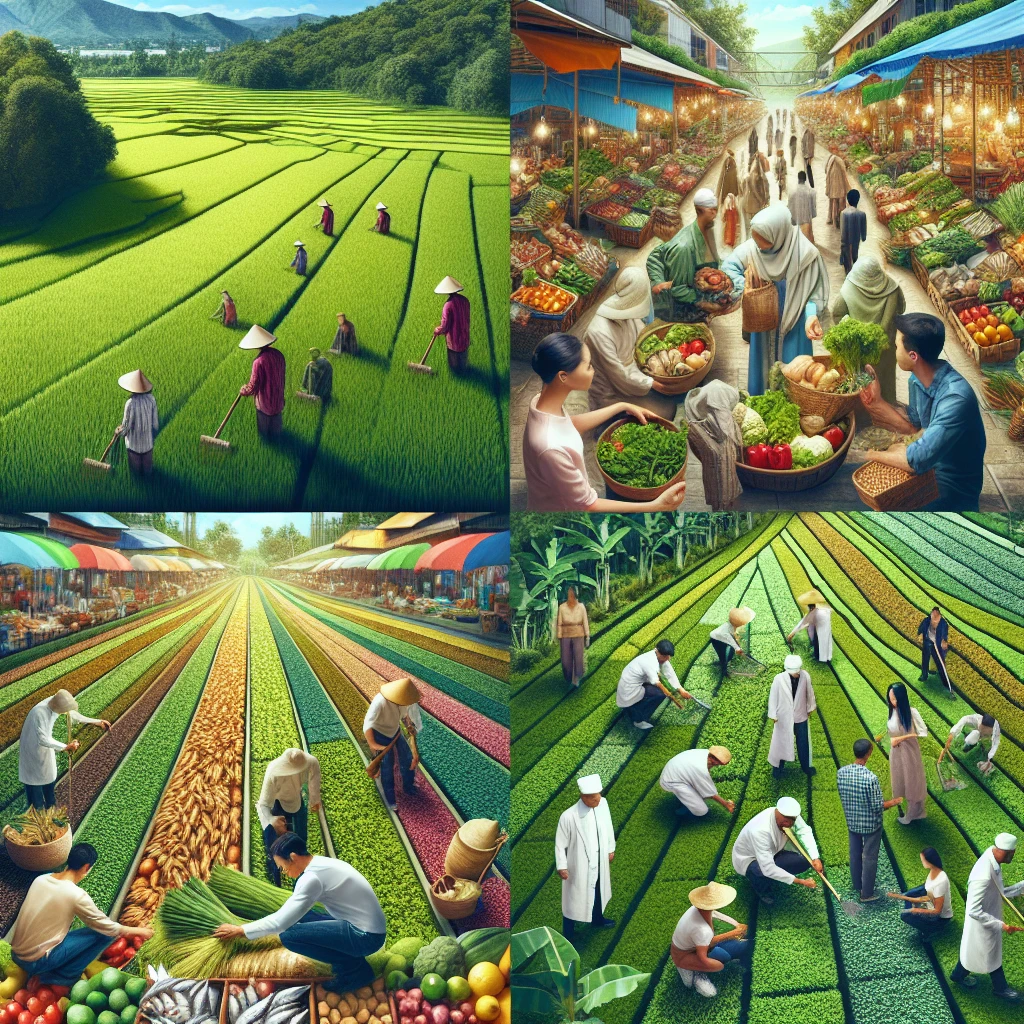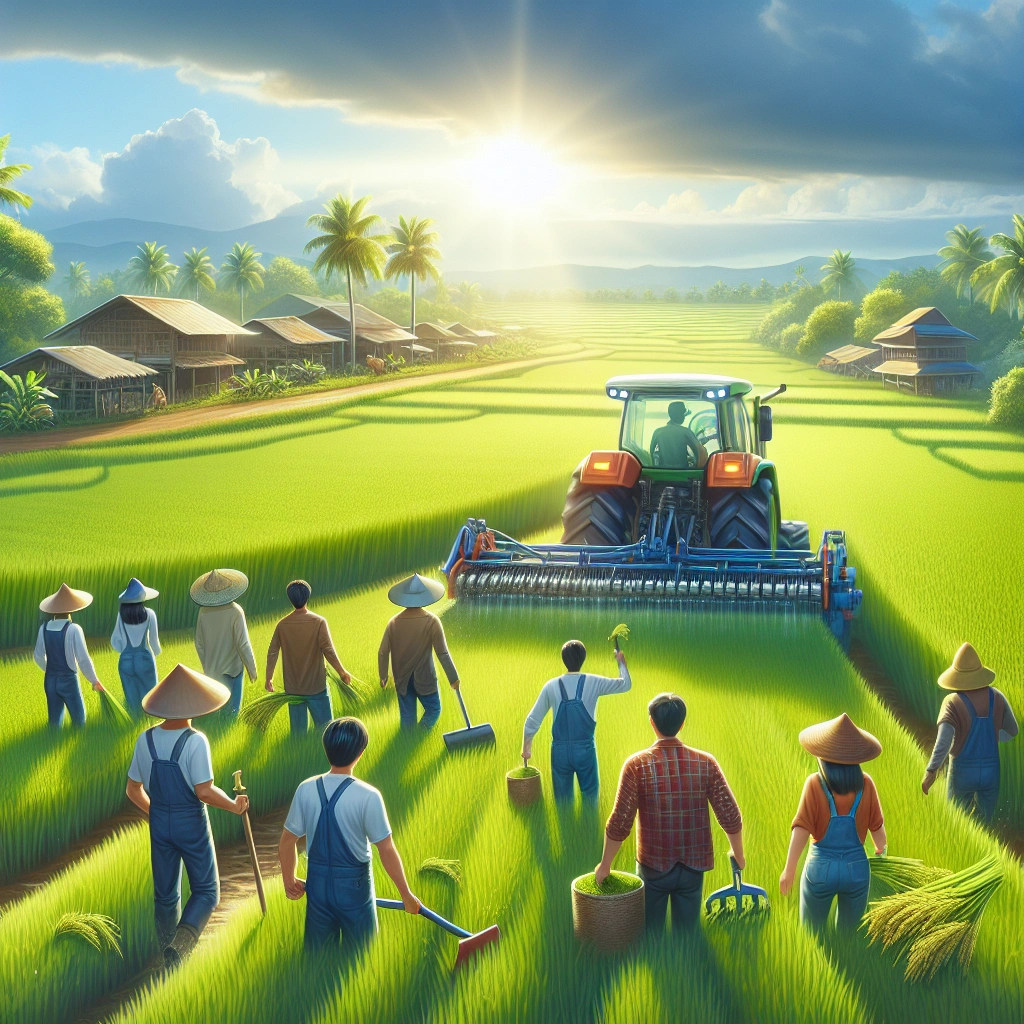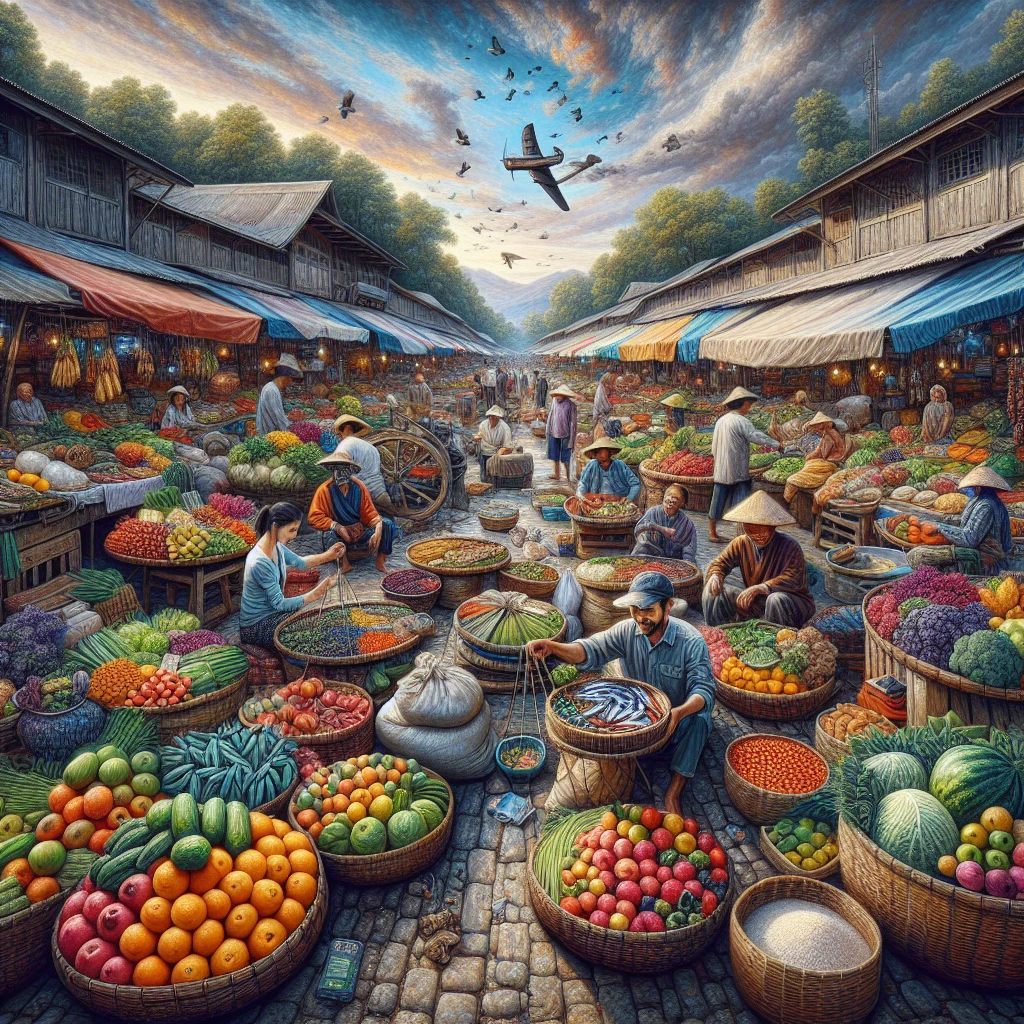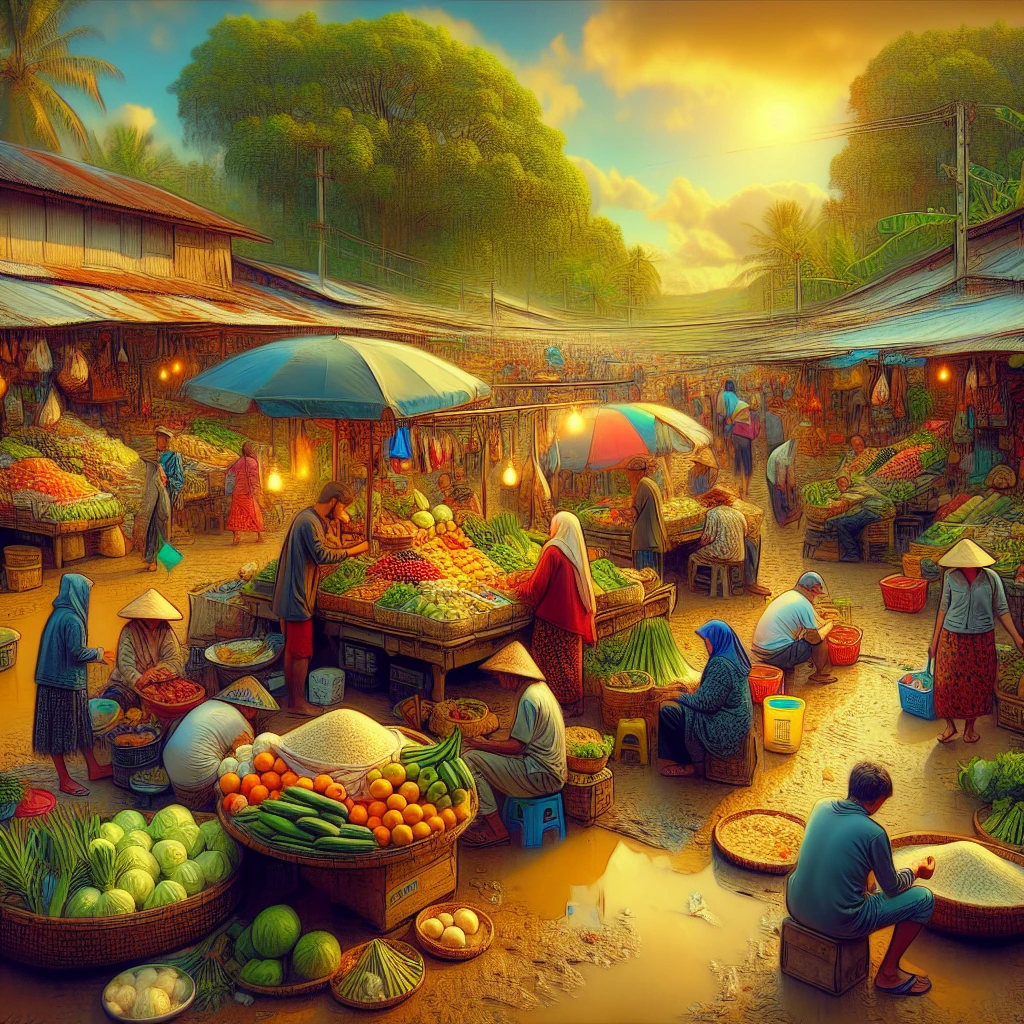

Food security in Southeast Asia is a critical issue that needs to be addressed urgently. With the impacts of agriculture on the region’s food production, including land degradation, water scarcity, and adverse climate change effects, the need for food security measures is more important than ever.
The importance of addressing food security in Southeast Asia cannot be overstated. Close to 17 percent of total food available in the region is lost or wasted, further exacerbating the food security situation.
Additionally, the rapid population growth and climate volatility are expected to increase the demand for food by 40 percent by 2050, making it crucial to prioritize food security efforts in the region.
To combat the complex causes of food insecurity in Southeast Asia, addressing post-harvest losses, gender and age bias, feeding practices, water supply and sanitation, and parental knowledge is essential. The COVID-19 pandemic has also highlighted vulnerabilities in the region’s food security, emphasizing the need for comprehensive strategies to ensure a sustainable and secure food supply for the people of Southeast Asia.
Check out this Youtube video: “World Food Day 2022: Bringing Southeast Asia” to gain valuable insights into the current state of food security in Southeast Asia and how it impacts the region’s population and economy.
Overview of Food Security in Southeast Asia
Southeast Asia faces significant challenges in ensuring food security due to constraints such as limited agricultural resources and land degradation. Urbanization, industrialization, and land-use changes have led to a decrease in arable land availability, further exacerbating the issue.
As the population in this region grows, the amount of food lost also increases, posing a critical obstacle to sustainable food production.
Understanding the Current State of Food Security
The current state of food security in Southeast Asia is precarious, with the COVID-19 pandemic halting progress made in addressing key challenges. Climate change and crop productivity issues have been worsened by the pandemic, revealing previously unknown vulnerabilities in the region’s food security landscape.
Historical Background of Food Security Issues in the Region
Historically, Southeast Asia’s agricultural landscape has encountered significant challenges presented by climate change, leading to substantial production losses due to extreme weather events. The region has grappled with multifaceted food security challenges, including limited resources, inadequate infrastructure, and vulnerability to external shocks.
These historical factors continue to shape the food security issues in Southeast Asia.
Factors Affecting Food Security in Southeast Asia
Climate Change and its Impact on Agriculture
The rising effects of climate change present a substantial threat to agricultural productivity in Southeast Asia. With extreme weather events such as droughts, heat waves, unpredictable rainfall patterns, and floods, farmers are facing significant challenges in sustaining crop yields.
For instance, Thailand and Viet Nam may experience agricultural losses ranging from 15.1% to 26.2% due to climate change. The need to adapt agricultural practices, such as altering sowing times, crop rotation, and the use of climate-resilient breeds, has become imperative in mitigating the impact of climate change on agricultural production.
Land and Water Scarcity
Southeast Asia grapples with the grave issue of land and water scarcity, exacerbated by rapid urbanization and population growth. The depletion of arable land due to urban expansion, industrialization, and shifting land use patterns has posed alarming challenges to food production and sustainability. Moreover, water scarcity is intensifying, with a projected 40% of developing Asia facing severe water shortages by 2030. The region’s finite supply of water is under immense pressure due to the burgeoning demand resulting from population growth and urban encroachment.
Population Growth and Urbanization
The soaring rates of population growth and urbanization in Southeast Asia have significantly impacted food security. It is estimated that the region’s population will surge by 12% by 2035, reaching 750 million, thereby escalating the demand for food by a staggering 40% by 2050. Urbanization has further catalyzed this challenge, with nearly 55% of the massive population expected to reside in urban areas by 2030. This rapid pace of urbanization emphasizes the critical need to address urban food security and nutrition, ensuring the sustenance of the burgeoning population.
| Factors | Impact |
|---|---|
| Climate Change | Agricultural losses of 15.1% to 26.2% in Southeast Asia due to climate change |
| Water Scarcity | 40% of developing Asia projected to face severe water shortages by 2030 |
| Population Growth | Demand for food to rise by 40% in Southeast Asia by 2050 |
Challenges in Achieving Food Security
Lack of Infrastructure and Technology
Infrastructure and technology play a crucial role in ensuring food security. In Southeast Asia, inadequate transportation networks and storage facilities hinder the efficient distribution of food. Additionally, the lack of advanced agricultural technology limits the region’s capacity to increase crop productivity and ensure long-term food sustainability. To illustrate, the absence of proper irrigation systems in rural areas restricts farmers from optimizing their yields, contributing to food scarcity.
Income Inequality and Poverty
Income inequality and poverty pose significant challenges to achieving food security in Southeast Asia. The disparity in wealth distribution results in limited access to nutritious food for marginalized communities. This creates a vicious cycle where impoverished individuals struggle to afford essential dietary requirements, leading to malnutrition and food insecurity. For example, rural families with low incomes often face obstacles in purchasing diverse and healthy food options, impacting their overall well-being.
Political Instability and Conflict
Political instability and conflict have a profound impact on food security in Southeast Asia. Nations embroiled in political unrest face disruptions in food distribution and trade, which directly affect the availability and affordability of essential food items. Moreover, conflicts over natural resources and territorial disputes can impede agricultural activities, exacerbating the region’s vulnerability to food insecurity. For instance, internal conflicts in certain Southeast Asian countries have hampered agricultural production, exacerbating the food shortage in those regions.
| Challenges | Impact on Food Security |
|---|---|
| Lack of Infrastructure | Hinders efficient food distribution and agricultural growth |
| Income Inequality | Limits access to nutritious food for marginalized groups |
| Political Instability | Disrupts food distribution and agricultural activities |
Addressing these challenges is imperative in promoting sustainable food security across Southeast Asia. Efforts to invest in infrastructure, tackle income inequality, and foster political stability are essential for ensuring access to adequate and nutritious food for all individuals in the region.
Impact of COVID-19 on Food Security
Disruption of Supply Chains
COVID-19 has significantly disrupted food supply chains in Southeast Asia, causing widespread delays and shortages. With movement restrictions and closures of food production facilities, the transportation and logistics sector has faced considerable challenges.
This disruption has led to a scarcity of essential food items and an increase in market prices, placing a strain on the region’s food security.
Economic Downturn and Food Insecurity
The economic downturn resulting from the COVID-19 pandemic has exacerbated food insecurity in Southeast Asia. With job losses and reduced incomes, many individuals and families are struggling to afford an adequate and nutritious diet.
This has led to a rise in acute food insecurity, posing a serious threat to the well-being of the population.
Response from Governments and NGOs
Governments and non-governmental organizations (NGOs) in Southeast Asia have been actively addressing the challenges posed by the impact of COVID-19 on food security. Through various initiatives such as food distribution programs, financial assistance, and community support, efforts are being made to alleviate food insecurity and ensure access to essential nutrition.
Additionally, collaborations with international partners and aid organizations are contributing to mitigating the adverse effects of the pandemic on the region’s food supply.
| Impacts | Measures |
|---|---|
| Supply chain disruptions | Movement restrictions and closures of production facilities |
| Economic downturn | Job losses and reduced incomes |
| Government and NGO response | Food distribution programs and financial assistance |
This table highlights the critical impacts of COVID-19 on food security in Southeast Asia and the corresponding measures taken to address these challenges.
Leaders of Southeast Asia must work together and innovate to secure the food supply chain. We will crush this disruption and ensure our people have access to the food they need.
Approaches to Addressing Food Security
Sustainable Agriculture Practices
Sustainable agriculture practices in Southeast Asia involve utilizing local resources, such as organic fertilizers, to maintain soil quality and reduce erosion. By promoting efficient water usage and protecting natural resources, future generations can also benefit from these practices, ensuring long-term food security in the region.
Promotion of Crop Diversity
In Southeast Asia, the promotion of crop diversity is essential for improving food stocks and enhancing income through the sale of a variety of crops. This approach not only enhances food security but also contributes to the improvement of consumption patterns and overall agricultural resilience in the region.
Investment in Agricultural Research and Development
Investing in agricultural research and development in Southeast Asia is crucial for enhancing food safety, improving dietary diversity, and increasing farm productivity. Such investments have a direct impact on reducing food prices, boosting crop and livestock yields, and ultimately contributing to the overall food security in the region.
| Sustainable Agriculture Practices | Promotion of Crop Diversity | Investment in Agricultural Research and Development |
|---|---|---|
| Utilizing local resources | Improving food stocks | Enhancing food safety and nutrition |
| Reducing water usage | Enhancing income | Boosting crop and livestock yields |
| Protecting natural resources | Improving consumption patterns | Reducing food prices |
The comprehensive approach to addressing food security in Southeast Asia encompasses sustainable agriculture practices, promotion of crop diversity, and investment in agricultural research and development, laying the foundation for a resilient and secure food system in the region.
Role of Government Policies
Subsidies and Price Controls
Government policies in Southeast Asia play a crucial role in ensuring food security through subsidies and price controls. By providing financial assistance to farmers and regulating food prices, the government aims to stabilize the food market and ensure affordable access to essential food items for the population.
These interventions help mitigate the impact of fluctuating market conditions and external factors, ultimately contributing to enhanced food security in the region.
Food Distribution Programs
In addressing food security in Southeast Asia, government-led food distribution programs are instrumental in ensuring that essential food items reach vulnerable populations. These programs facilitate the equitable distribution of food supplies, particularly to underserved communities and remote regions.
By establishing efficient logistics and supply chains, the government can effectively manage and allocate food resources to areas in need, thereby addressing the challenge of food scarcity and promoting accessibility throughout the region.
Collaboration with International Organizations
Collaboration with international organizations presents a valuable opportunity for Southeast Asian governments to enhance their food security initiatives. By partnering with organizations like the World Food Program (WFP) and the Food and Agriculture Organization (FAO), governments can access resources, expertise, and assistance in implementing sustainable food security strategies.
Furthermore, international collaboration enables the exchange of best practices and innovative approaches to addressing food insecurity, fostering a collective effort towards achieving meaningful and lasting impact in the region.
| Subheading | Role | Impact |
|---|---|---|
| Subsidies and Price Controls | Stabilizing food prices | Mitigating market fluctuations |
| Food Distribution Programs | Equitable allocation | Addressing food scarcity |
| Collaboration with International Organizations | Access to resources and expertise | Implementing sustainable strategies |
By proactively leveraging government policies in these areas, Southeast Asia can effectively address food security challenges, ultimately ensuring a stable and reliable food supply for its population.
Role of Civil Society and NGOs
Community-Based Initiatives
Community engagement is crucial for addressing food insecurity in Southeast Asia. Civil society organizations can spearhead community-based initiatives such as community gardens, food banks, and nutrition education programs to empower local communities.
These initiatives foster self-sufficiency and resilience, ensuring sustainable access to nutritious food for vulnerable populations. By mobilizing communities, NGOs can create impactful long-term solutions to food insecurity.
Education and Advocacy
NGOs play a vital role in raising awareness about food security issues through education and advocacy efforts. They can organize workshops, seminars, and campaigns to educate communities about sustainable agriculture practices, nutrition, and food preservation techniques.
Additionally, civil society organizations advocate for policy changes and government support to address the root causes of food insecurity. Through strategic advocacy, NGOs contribute to shaping effective policies and initiatives to ensure food security for all.
Relief and Assistance Programs
In times of crisis or natural disasters, civil society organizations swiftly respond with relief and assistance programs to address immediate food needs. These programs include food distribution, emergency feeding programs, and provision of essential supplies to affected communities.
NGOs facilitate partnerships with local and international agencies to deliver timely aid, mitigating the impact of food crises and ensuring access to nutritious food during emergencies.
| Community-Based Initiatives | Education and Advocacy | Relief and Assistance Programs |
|---|---|---|
| Community gardens | Workshops and seminars | Food distribution |
| Food banks | Advocacy campaigns | Emergency feeding programs |
| Nutrition education programs | Policy advocacy | Provision of essential supplies |
This table showcases the diverse initiatives and programs spearheaded by civil society and NGOs to combat food insecurity in Southeast Asia, addressing the multifaceted challenges faced by local communities.
Importance of International Collaboration
Regional Partnerships and Agreements
International collaboration is crucial for establishing regional partnerships and agreements that aim to enhance food security in Southeast Asia. By working together, countries can overcome trade barriers and develop strategic alliances to ensure the efficient exchange of agricultural products.
For instance, the Regional Comprehensive Economic Partnership (RCEP) deepens trade and investment relations between member countries, facilitating the reduction of non-tariff barriers on agricultural goods. Such collaborations foster a conducive policy environment and facilitate the flow of vital resources across borders, ultimately contributing to improved food security in the region.
Support from Global Organizations
The support from global organizations plays a pivotal role in shaping international collaboration efforts for food security in Southeast Asia. Organizations like the International Monetary Fund (IMF) and the World Trade Organization (WTO) actively engage in enhancing trade-related collaboration to achieve common goals.
This support includes the provision of strategic guidance and financial assistance, enabling countries in Southeast Asia to overcome economic hurdles and bolster their agricultural capabilities. As a result, these nations can address specific food security challenges and leverage the expertise of global organizations to implement effective solutions.
Sharing of Best Practices and Innovation
International collaboration fosters the sharing of best practices and innovation, essential for addressing food security in Southeast Asia. Through collaboration, multinational enterprises (MNEs) can engage in high-quality innovation, driving impactful solutions for agricultural productivity and sustainability.
Moreover, global innovators have the opportunity to exchange insights and knowledge, leading to the development of advanced agricultural technologies and practices. This sharing of best practices and innovation not only bolsters the region’s food security but also contributes to the global agricultural landscape through the introduction of groundbreaking methodologies and technologies.
| Regional Partnerships and Agreements | Support from Global Organizations | Sharing of Best Practices and Innovation |
|---|---|---|
| RCEP facilitates trade relations | IMF and WTO provide financial support | MNEs drive innovation for sustainability |
| Overcoming trade barriers | Guidance and assistance for economic hurdles | Exchange of agricultural best practices |
| Enhances flow of resources | Addressing food security challenges | Development of advanced agricultural technologies |
This table highlights the key aspects of international collaboration, showcasing the impacts and benefits across regional partnerships, global support, and innovation sharing.
Remember, it’s all about collaboration and working together to tackle the challenges of food security in Southeast Asia.
Innovations in Addressing Food Security
Technology in Agriculture
The use of modern technology in agriculture has revolutionized the industry, enhancing productivity, efficiency, and sustainability. Robotics, temperature sensors, aerial imagery, and GPS technology are now common tools in farming, enabling precise monitoring and management of crops.
For example, drones equipped with advanced imaging systems can provide valuable insights into crop health and enable targeted interventions. Additionally, precision agriculture and robotic systems allow for optimized resource usage, reducing waste and environmental impact.
Aquaculture and Sustainable Fishing Practices
Innovative approaches in aquaculture and sustainable fishing practices play a crucial role in bolstering food security in Southeast Asia. Technologies such as vertical farming systems, hydroponics, and aquaponics are being implemented to maximize resources and enhance food resilience.
Moreover, advancements in disease prevention, vaccine delivery, and sustainability solutions are transforming the aquaculture industry, ensuring a sustainable supply of aquatic food. These practices not only address food security challenges but also promote environmental sustainability and economic growth in the region.
Food Waste Reduction Strategies
Efficient management of food waste is essential for ensuring food security in Southeast Asia. Utilizing big data and food waste analytics enables businesses to identify and address wastage hotspots, leading to significant reductions in food loss.
Moreover, implementing donation programs and partnering with organizations to redistribute surplus food can effectively minimize waste and contribute to addressing food insecurity. Creating awareness and training staff in temperature management and inventory control also play a vital role in reducing food waste across the supply chain.
| Technology in Agriculture | Aquaculture and Sustainable Fishing Practices | Food Waste Reduction Strategies |
|---|---|---|
| Robotics and precision agriculture techniques optimize resource usage. | Innovative aquaculture technologies enhance food resilience and sustainability. | Utilizing big data and analytics to identify and reduce food wastage hotspots. |
| Aerial imagery and GPS technology enable precise monitoring and management of crops. | Advancements in disease prevention and vaccine delivery ensure a sustainable supply of aquatic food. | Implementing donation programs and surplus food redistribution to minimize waste. |
| Drones equipped with advanced imaging systems provide valuable insights into crop health. | Hydroponics and aquaponics maximize resources and promote environmental sustainability. | Creating awareness and training staff in temperature management and inventory control. |
Embracing technological advancements in agriculture, implementing innovative practices in aquaculture, and adopting effective food waste reduction strategies are vital steps towards addressing food security in Southeast Asia. These concerted efforts not only ensure a sustainable food supply but also contribute to environmental conservation and economic development in the region.
Balancing Economic Growth and Food Security
Impact of Industrialization on Agriculture
The impact of industrialization on agriculture in Southeast Asia has been profound. With the advent of industrial farming, the region experienced a shift from traditional farming methods to large-scale monoculture production.
This transition has had both positive and negative consequences. While it has significantly increased food production, it has also led to a loss of agricultural diversity, heightened environmental degradation, and reduced resilience against climate change and pests.
The region’s agricultural landscape has been reshaped, influencing food security and economic growth in complex ways.
Importance of Sustainable Development
In Southeast Asia, sustainable development is crucial for achieving a balance between economic growth and food security. Embracing sustainable agricultural practices, such as agroecology and organic farming, can mitigate the negative impacts of industrialization.
By promoting biodiversity, protecting natural resources, and incorporating innovative farming techniques, sustainable development can enhance food security while contributing to the region’s economic growth. This approach ensures that future generations can continue to meet their nutritional needs without compromising the environment.
Case Studies of Successful Implementation
Some notable case studies of successful implementation of sustainable agricultural practices in Southeast Asia include the promotion of community-supported agriculture (CSA) in Thailand, the adoption of agroforestry systems in the Philippines, and the utilization of efficient water management techniques in Vietnam. These initiatives have demonstrated the potential of sustainable development to improve food security while also fostering economic prosperity.
By integrating traditional knowledge with modern innovations, these case studies serve as inspiring models for achieving a harmonious balance between economic growth and food security in the region.
| Country/Region | Sustainable Practice | Impact |
|---|---|---|
| Thailand | Community-Supported Agriculture | Enhanced local food security |
| Philippines | Agroforestry Systems | Improved soil fertility and crop yields |
| Vietnam | Efficient Water Management | Increased agricultural productivity |
By learning from these successful initiatives, Southeast Asia can progress towards a future where economic growth and food security thrive in harmony, ensuring a sustainable and resilient food system for all.
Ethical Considerations in Addressing Food Security
Fair Trade Practices
Fair trade practices in Southeast Asia ensure that workers receive fair wages and are protected from market fluctuations. By implementing fair trade certifications, brands demonstrate their commitment to ethical sourcing and production. However, it’s essential to prioritize fair treatment for all workers in the food and farming industry, not just those covered by certifications.
Ensuring Access to Nutritious Food
Programs such as the Gus Schumacher Nutrition Incentive Program and initiatives by the Centers for Disease Control and Prevention help address the access and affordability of healthy foods in Southeast Asia. These efforts aim to combat food deserts in rural areas and improve healthy food access in various settings like worksites, hospitals, and food retail environments.
Balancing Economic Growth and Environmental Sustainability
Southeast Asia can achieve a balance between economic growth and environmental sustainability by adopting sustainable practices such as waste reduction, energy conservation, and environmentally focused agricultural policies. Government investments in research and technology adoption play a crucial role in achieving this balance, which ultimately contributes to more sustainable, resilient, and inclusive food systems.
| Fair Trade Practices | Access to Nutritious Food | Balancing Economic Growth and Environmental Sustainability |
|---|---|---|
| Ensures fair wages and protection for workers | Addresses access and affordability of healthy foods | Achieves balance through sustainable practices and government investments |
Remember, the key to ethical considerations in addressing food security is maintaining fair trade practices, providing access to nutritious food, and balancing economic growth with environmental sustainability in Southeast Asia.
Impact of Food Security on Health
Malnutrition and Its Effects
Malnutrition in Southeast Asia has grave effects on the health of both children and adults. For example, undernutrition contributes to stunting, wasting, and underweight issues in children, leading to weakened immune systems and making them more vulnerable to common infections.
In fact, nearly half of all deaths in children under 5 in the region are attributable to undernutrition. Additionally, malnutrition presents inadequate vitamins or minerals and deficiencies in vitamins and minerals, further exacerbating health issues.
Public Health Implications of Food Insecurity
The public health implications of food insecurity are dire, with increased risks of obesity, chronic diseases, and mental health disorders among adults who experience food insecurity. Studies have found a direct correlation between food insecurity and higher rates of chronic diseases, such as diabetes, heart disease, and obesity.
Furthermore, food insecurity can lead to limited access to nutritious food, resulting in a higher risk for multiple chronic health conditions in the region.
Strategies for Improving Nutrition in the Region
Effective strategies for improving nutrition in Southeast Asia include comprehensive school-based interventions, such as nutrition education, promotion, and family, community, and school food initiatives. Additionally, access to foods that support healthy dietary patterns can be improved through population education, point-of-purchase labeling, fiscal incentives and disincentives, and food assistance programs.
Furthermore, the United Nations Decade of Action on Nutrition aims to eliminate all forms of malnutrition, everywhere, leaving no one behind through sustained and coherent implementation of policies and programs.
| Strategy | Description |
|---|---|
| Comprehensive School-Based Interventions | Includes nutrition education and promotion, family, community, and school food initiatives. |
| Access to Foods Supporting Healthy Dietary Patterns | Strategies to improve access to nutritious food, such as population education and food assistance programs. |
| United Nations Decade of Action on Nutrition | Sustained implementation of policies and programs to eliminate malnutrition. |
Let’s make Southeast Asia’s food security great again!
Gender Equality and Food Security
Women’s Role in Agriculture
Women play a critical role in agriculture, contributing significantly to food production in Southeast Asia. In many developing countries in the region, women produce between 60 and 80 per cent of the food and are responsible for half of the world’s food production.
Their key role as food producers and providers is invaluable to ensuring food security in the region.
Empowerment and Access to Resources
Empowering women in agriculture is vital to improving food security and lifting rural communities out of poverty. By improving access to productive activities for women and enhancing their access to resources such as land and productive resources, we can make tremendous strides in ensuring food security in Southeast Asia.
Gender-Sensitive Approaches to Food Security
Implementing gender-sensitive approaches to food security is crucial for achieving sustainable and equitable outcomes. Designing interventions that provide equal access to food, productive resources, education, and decision-making for both men and women is essential in ensuring long-term food security in Southeast Asia.
| Women’s Role in Agriculture | Empowerment and Access to Resources | Gender-Sensitive Approaches to Food Security |
|---|---|---|
| Key players in food production | Vital in improving access to resources | Crucial for sustainable and equitable outcomes |
Recognizing and empowering women in agriculture and implementing gender-sensitive approaches are key elements in achieving food security in Southeast Asia.
Addressing Food Security in Conflict-affected Areas
Humanitarian Assistance
Food security in conflict-affected areas demands urgent humanitarian assistance to provide immediate relief and support to vulnerable populations. International organizations, such as the World Food Programme, play a crucial role in delivering food aid and nutrition support to those affected.
For example, the WFP has been instrumental in providing emergency food assistance to conflict-affected communities in Southeast Asia, ensuring access to essential nourishment during challenging times.
Long-term Solutions for Sustainable Development
Long-term solutions for sustainable development in conflict-affected areas involve investing in agricultural infrastructure, promoting self-sufficiency, and empowering local farmers. For instance, initiatives focused on enhancing agricultural productivity, providing training on sustainable farming practices, and establishing resilient food systems are essential for mitigating food insecurity in the long run.
Collaborative efforts by governments, NGOs, and international organizations are pivotal in driving sustainable development initiatives that directly address food security challenges in Southeast Asia.
Cross-border Cooperation and Assistance
Cross-border cooperation and assistance are imperative to address food security in conflict-affected areas, especially in regions like Southeast Asia where transboundary impacts are significant. For instance, facilitating the unimpeded flow of humanitarian aid, coordinating relief efforts across borders, and establishing partnerships with neighboring countries are crucial for ensuring efficient and effective assistance to populations in need.
Collaborative approaches can mitigate the impact of conflict on food security, fostering stability and resilience in the region.
| Example of Cross-border Cooperation |
|---|
| The ASEAN Plus Three Emergency Rice Reserve (APTERR) fosters cross-border cooperation by establishing a regional food security mechanism. Through this initiative, member countries, including those in conflict-affected areas, collaborate to address emergency food shortages and ensure timely assistance. APTERR exemplifies the importance of cross-border alliances in mitigating food insecurity in Southeast Asia. |
Remember, addressing food security in conflict-affected areas demands a multi-faceted approach, incorporating both short-term humanitarian assistance and long-term sustainable development strategies. Cross-border collaboration plays a pivotal role in enhancing the effectiveness of these endeavors, ultimately contributing to the alleviation of food insecurity in Southeast Asia.
The Future of Food Security in Southeast Asia
Opportunities for Innovation and Collaboration
Collaboration between governments, non-governmental organizations, and private sectors can drive innovation in agricultural practices, sustainable food production, and distribution networks. For example, leveraging technology such as precision agriculture, hydroponics, and vertical farming can optimize resource usage and boost crop yields, ensuring food security in the region.
Policy Recommendations for Governments
Governments should prioritize investment in agricultural research and development, infrastructure improvement, and climate-resilient farming techniques to mitigate the impact of climate change on food production. Additionally, implementing policies to promote diversified and resilient food systems, including support for small-scale farmers and sustainable land management practices, is crucial for enhancing food security in Southeast Asia.
The Role of Individuals in Promoting Food Security
Individuals can contribute to food security through sustainable consumption, support for local agricultural products, and participation in community-based food initiatives. By embracing sustainable dietary choices and advocating for equitable food access, individuals can play a significant role in promoting a resilient food ecosystem in Southeast Asia.
| Opportunities for Innovation and Collaboration | Policy Recommendations for Governments | The Role of Individuals in Promoting Food Security |
|---|---|---|
| Collaboration between stakeholders for technological advancement | Prioritize investment in agricultural research and sustainable farming techniques | Advocate for sustainable consumption and local food support |
By embracing these opportunities and policy initiatives while empowering individuals to make a positive impact, Southeast Asia can move towards a more secure and sustainable food future.
Recommended Amazon Products for Ensuring Food Security in Southeast Asia
Here’s a curated list of products that can help ensure food security in Southeast Asia. These recommendations are based on the functionality, price, and reviews of each product.
LifeStraw Personal Water Filter


The LifeStraw Personal Water Filter is an essential tool for ensuring access to clean drinking water in areas facing water scarcity. This compact and lightweight filter is highly recommended for its reliability and portability, making it an ideal solution for addressing water scarcity in Southeast Asia.
| Pros | Cons |
|---|---|
| Removes 99.9999% of waterborne bacteria and 99.9% of waterborne protozoan parasites | May require frequent cleaning in turbid or muddy water |
| Long-lasting – filters up to 4,000 liters of contaminated water without iodine, chlorine, or other chemicals | Does not filter out viruses |
Rice Storage Container


Efficient storage of staple foods like rice is crucial for food security. A rice storage container helps prevent waste and pest infestation, ensuring a stable food supply in the region.
| Pros | Cons |
|---|---|
| Airtight seal to keep rice fresh and free from pests | Large containers may take up significant space in smaller homes |
| Easy-to-use design for convenient access to rice | Some designs may be less visually appealing |
Solar-Powered Portable LED Light Bulb


Access to reliable lighting is essential for food production, cooking, and studying. This solar-powered LED light bulb offers an eco-friendly and cost-effective solution for off-grid communities in Southeast Asia.
| Pros | Cons |
|---|---|
| Energy-efficient and environmentally friendly | Limited brightness compared to traditional light bulbs |
| Portable and versatile for various lighting needs | Initial cost may be higher than standard light bulbs |
Victorinox Swiss Army Pocket Knife


A versatile tool like the Victorinox Swiss Army Pocket Knife can aid in agricultural tasks, food preparation, and emergency situations, contributing to overall food security in the region.
| Pros | Cons |
|---|---|
| Multiple functions such as cutting, slicing, and opening cans | May not be suitable for heavy-duty tasks |
| Compact and portable for everyday use | Needs to be handled with care to avoid accidents |
Collapsible Rain Barrel


Harvesting rainwater can be a sustainable solution to water scarcity challenges. A collapsible rain barrel allows for easy collection and storage of rainwater for agricultural and household use.
| Pros | Cons |
|---|---|
| Space-saving design when not in use | Limited capacity compared to traditional rain barrels |
| Durable and weather-resistant material | Some assembly and maintenance required |
Top Recommended Product for Ensuring Food Security in Southeast Asia
If you’re looking for the best solution for ensuring food security in Southeast Asia we highly recommend the LifeStraw Personal Water Filter. This reliable and portable filter is an essential tool for ensuring access to clean drinking water in the region, making it a crucial component of food security efforts.
Ready to improve food security in Southeast Asia? Check out the LifeStraw Personal Water Filter today for the best results!


Conclusion
The key challenges to food security in Southeast Asia include climate change, limited access to modern agricultural techniques, and the lack of infrastructure for food distribution. Solutions to these challenges involve investing in climate-resilient crops, providing training and resources for small-scale farmers, and improving transportation and storage facilities.
By implementing these solutions, Southeast Asia can work towards achieving sustainable food security for its population.
The call to action for addressing food security in Southeast Asia is for governments, organizations, and individuals to prioritize investment in agricultural research, development, and infrastructure. It is important to support small-scale farmers and provide them with the necessary tools and knowledge to improve their productivity and resilience to climate change.
Furthermore, collaboration and coordination between countries in the region are essential to ensure a consistent and effective approach to tackling food security issues in Southeast Asia.
Addressing food security in Southeast Asia requires a multi-faceted approach that focuses on building resilience to climate change, improving agricultural techniques, and enhancing food distribution infrastructure. It is crucial for stakeholders to come together and prioritize investment in agriculture and support for small-scale farmers in order to achieve sustainable and lasting food security in the region.

